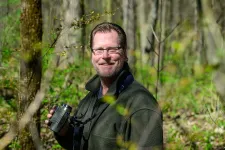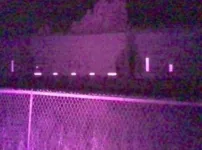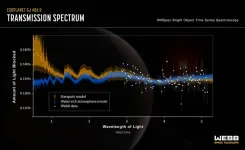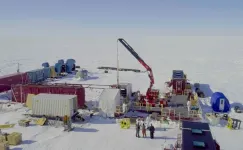(Press-News.org) [EMBARGOED UNTIL May 1, 2023 at 3:00 PM U.S. Eastern time]
Reports of near-death experiences--with tales of white light, visits from departed loved ones, hearing voices, among other attributes—capture our imagination and are deeply engrained in our cultural landscape.
The fact that these reports share so many common elements begs the question of whether there is something fundamentally real underpinning them—and that those who have managed to survive death are providing glimpses of a consciousness that does not completely disappear, even after the heart stops beating.
A new study published in the Proceedings of the National Academy of Science, provides early evidence of a surge of activity correlated with consciousness in the dying brain.
The study, led by Jimo Borjigin, Ph.D., associate professor in the Department of Molecular & Integrative Physiology and the Department of Neurology, and her team is a follow-up to animal studies conducted almost ten years ago in collaboration with George Mashour, M.D., Ph.D., the founding director of the Michigan Center for Consciousness Science.
Similar signatures of gamma activation were recorded in the dying brains of both animals and humans upon a loss of oxygen following cardiac arrest.
“How vivid experience can emerge from a dysfunctional brain during the process of dying is a neuroscientific paradox. Dr. Borjigin has led an important study that helps shed light on the underlying neurophysiologic mechanisms,” said Mashour.
The team identified four patients who passed away due to cardiac arrest in the hospital while under EEG monitoring. All four of the patients were comatose and unresponsive. They were ultimately determined to be beyond medical help and, with their families’ permission, removed from life support.
Upon removal of ventilator support, two of the patients showed an increase in heart rate along with a surge of gamma wave activity, considered the fastest brain activity and associated with consciousness.
Furthermore, the activity was detected in the so-called hot zone of neural correlates of consciousness in the brain, the junction between the temporal, parietal and occipital lobes in the back of the brain. This area has been correlated with dreaming, visual hallucinations in epilepsy, and altered states of consciousness in other brain studies.
These two patients had previous reports of seizures, but no seizures during the hour before their deaths, explained Nusha Mihaylova, M.D., Ph.D., a clinical associate professor in the Department of Neurology who has collaborated with Dr. Borjigin since 2015 by collecting EEG data from deceased patients under ICU care. The other two patients did not display the same increase in heartrate upon removal from life support nor did they have increased brain activity.
Because of the small sample size, the authors caution against making any global statements about the implications of the findings. They also note that it’s impossible to know in this study what the patients experienced because they did not survive.
“We are unable to make correlations of the observed neural signatures of consciousness with a corresponding experience in the same patients in this study. However, the observed findings are definitely exciting and provide a new framework for our understanding of covert consciousness in the dying humans,” she said.
Larger, multi-center studies including EEG-monitored ICU patients who survive cardiac arrest, could provide much needed data to determine whether or not these bursts in gamma activity are evidence of hidden consciousness even near death.
Additional authors on this paper include Gang Xu, Duan Li, Fangyun Tian, Peter M. Farrehi, Jack M. Parent and Michael Wang.
Paper cited: “Surge of neurophysiological coupling and connectivity of gamma oscillations in the dying human brain," Proceedings of the National Academy of Science (PNAS).
END
Evidence of conscious-like activity in the dying brain
A small study finds intriguing brain wave patterns in comatose patients who died following cardiac arrest
2023-05-01
ELSE PRESS RELEASES FROM THIS DATE:
50-year study offers insight into effects of climate on bird reproduction
2023-05-01
CHAMPAIGN, Ill. — A new study reported in the Proceedings of the National Academy of Sciences assessed changes in the reproductive output of 104 bird species around the world between 1970 and 2019. The study reveals that a warming climate appears to have more worrisome effects on larger birds and migratory birds than on smaller, sedentary species.
Study co-author Jeffrey Hoover, an avian ecologist at the Illinois Natural History Survey describes the findings in an interview with University of Illinois Urbana-Champaign life sciences editor Diana Yates.
Some highlights:
Increasing local temperatures during the chick-rearing part of the ...
Coal trains increase air pollution in San Francisco bay area
2023-05-01
Coal trains and terminal operations add a significant amount of fine particulate matter (PM2.5) pollution to urban areas, more so than other freight or passenger trains, according to a study conducted in Richmond, California, by the University of California, Davis.
The paper, published in the journal Air Quality, Atmosphere & Health, is the first study of coal train particulate pollution in a U.S. urban area. It’s also the first to use artificial intelligence technologies to verify that the source of air pollution detected comes from coal.
It found that passing trains carrying ...
Silver nanoparticles spark key advance in thermoelectricity for power generation
2023-05-01
HOUSTON – Several high-performance thermoelectric materials have been discovered over the past two decades, but without efficient devices to convert the energy they produce into emission-free power, their promise has been unfulfilled. Now an international team of scientists led by a University of Houston physicist and several of his former students has reported a new approach to constructing the thermoelectric modules, using silver nanoparticles to connect the modules’ electrode and metallization layers.
The ...
A new method to test cancer drug toxicity
2023-05-01
For people with cancer, chemotherapy saves lives, but for some patients, the treatment comes with a side effect—heart damage. Screening cancer drugs for cardiotoxicity has been an ongoing challenge as heart cells don’t naturally grow in a dish, requiring researchers to do this critical testing using cardiac tissue from rodent models. A new study from researchers at Cummings School of Veterinary Medicine at Tufts University and Tufts Medical Center reports that heart tissue obtained through organ donations from dogs dying of other causes are a promising platform for testing cancer drug toxicity, offering scientists a new alternative.
The ...
Webb finds water vapor, but from a rocky planet or its star?
2023-05-01
The most common stars in the universe are red dwarf stars, which means that rocky exoplanets are most likely to be found orbiting such a star. Red dwarf stars are cool, so a planet has to hug it in a tight orbit to stay warm enough to potentially host liquid water (meaning it lies in the habitable zone). Such stars are also active, particularly when they are young, releasing ultraviolet and X-ray radiation that could destroy planetary atmospheres. As a result, one important open question in astronomy is whether a rocky planet could maintain, or reestablish, an atmosphere in such a harsh environment.
To help answer that question, astronomers ...
Cannabis knocks down pain, improves sleep and lifts brain fog in cancer patients
2023-05-01
Cancer patients who use cannabis to address their symptoms have less pain and sleep better, according to new University of Colorado Boulder research. But they also experience another, unexpected, benefit: After a few weeks of sustained use, they seem to think more clearly.
“When you’re in a lot of pain, it’s hard to think,” said senior author Angela Bryan, a professor of psychology and neuroscience at CU Boulder and a cancer survivor. “We found that when patients’ pain levels came down after using cannabis for a while, their cognition got better.”
The small but groundbreaking study, published ...
Jutras Lab awarded $1.2 million to create rapid and accurate Lyme disease testing
2023-05-01
A rapid, at-home test that can diagnose acute Lyme disease? That is the goal for researcher Brandon Jutras and his team at Virginia Tech’s Fralin Life Sciences Institute.
Through the support of a recent $1.2 million multiyear therapeutic/diagnostic research tick-borne disease grant awarded by the Department of Defense, Jutras' vision may one day become a reality. This research award aims to improve patient care and quality of life for military service members, veterans, and their beneficiaries as well as the American public living with Lyme disease and other tick-borne diseases.
“Current ...
Study: Police murder of George Floyd associated with short-term spike in firearm assaults on US police officers
2023-05-01
The police murder of George Floyd sparked nationwide protests in the summer of 2020 and revived claims that public outcry over such high-profile police killings perpetuates a violent “war on cops.” In a new study, researchers assessed if and how patterns of firearm assault on police officers in the United States were influenced by the police murder of Floyd. The study found that Floyd’s murder was associated with a three-week spike in firearm assaults on police, after which the trend in such assaults dropped to levels slightly above those predicted by pre-Floyd ...
West Antarctic Ice Sheet retreated far inland, re-advanced since last Ice Age
2023-05-01
WASHINGTON — The West Antarctic Ice Sheet is melting rapidly, raising concerns it could cross a tipping point of irreversible retreat in the next few decades if global temperatures rise 1.5 to 2.0 degrees Celsius (2.7 to 3.8 degrees Fahrenheit) above preindustrial levels. New research finds that 6,000 years ago, the grounded edge of the ice sheet may have been as far as 250 kilometers (160 miles) inland from its current location, suggesting the ice retreated deep into the continent after the end of the last ice age and re-advanced before modern retreat began.
“In the last few thousand years before we started watching, ...
Young women more likely to return to the hospital in year following heart attack
2023-05-01
Young women who experience a heart attack have more adverse outcomes and are more likely to end up back in the hospital compared to men of a similar age in the year following discharge. According to a study published in the Journal of the American College of Cardiology, second heart attack and chest pain due to the heart are the most common causes of rehospitalization, but non-cardiac hospitalizations showed the most significant disparity.
“This all begins with public awareness towards preventing heart attacks and screening ...
LAST 30 PRESS RELEASES:
Interaction of climate change and human activity and its impact on plant diversity in Qinghai-Tibet plateau
From addressing uncertainty to national strategy: an interpretation of Professor Lim Siong Guan’s views
Clinical trials on AI language model use in digestive healthcare
Scientists improve robotic visual–inertial trajectory localization accuracy using cross-modal interaction and selection techniques
Correlation between cancer cachexia and immune-related adverse events in HCC
Human adipose tissue: a new source for functional organoids
Metro lines double as freight highways during off-peak hours, Beijing study shows
Biomedical functions and applications of nanomaterials in tumor diagnosis and treatment: perspectives from ophthalmic oncology
3D imaging unveils how passivation improves perovskite solar cell performance
Enriching framework Al sites in 8-membered rings of Cu-SSZ-39 zeolite to enhance low-temperature ammonia selective catalytic reduction performance
AI-powered RNA drug development: a new frontier in therapeutics
Decoupling the HOR enhancement on PtRu: Dynamically matching interfacial water to reaction coordinates
Sulfur isn’t poisonous when it synergistically acts with phosphine in olefins hydroformylation
URI researchers uncover molecular mechanisms behind speciation in corals
Chitin based carbon aerogel offers a cleaner way to store thermal energy
Tracing hidden sources of nitrate pollution in rapidly changing rural urban landscapes
Viruses on plastic pollution may quietly accelerate the spread of antibiotic resistance
Three UH Rainbow Babies & Children’s faculty elected to prestigious American Pediatric Society
Tunnel resilience models unveiled to aid post-earthquake recovery
Satellite communication systems: the future of 5G/6G connectivity
Space computing power networks: a new frontier for satellite technologies
Experiments advance potential of protein that makes hydrogen sulfide as a therapeutic target for Alzheimer’s disease
Examining private equity’s role in fertility care
Current Molecular Pharmacology achieves a landmark: real-time CiteScore advances to 7.2
Skeletal muscle epigenetic clocks developed using postmortem tissue from an Asian population
Estimating unemployment rates with social media data
Climate policies can backfire by eroding “green” values, study finds
Too much screen time too soon? A*STAR study links infant screen exposure to brain changes and teen anxiety
Global psychiatry mourns Professor Dan Stein, visionary who transformed mental health science across Africa and beyond
KIST develops eco-friendly palladium recovery technology to safeguard resource security
[Press-News.org] Evidence of conscious-like activity in the dying brainA small study finds intriguing brain wave patterns in comatose patients who died following cardiac arrest





